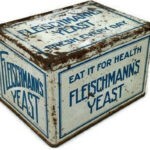It was called
“The Hot Weather Food“
but what was it really?

This advertisement from McCall’s Magazine,
August 1903, explains that:
“At three months these twins were put on Eskay’s Food, when one was in a critical condition from lack of food that nourished. At 14 months they are strong, healthy and perfectly developed and each has fourteen teeth, which came without the least trouble.”
But why were they given Eskay’s Food and why is it called The Hot Weather Food?
Their mother, Mrs. Sarah Weaver, Chelsea, Mass., asserts: “My twin babies have received wonderful benefits from Eskay’s Food. We tried nearly every other food but nothing was satisfactory. We have used Eskay’s Food for some months now – and during the hottest weather the babies are growing stronger and constantly increasing in size and weight.”
Perhaps it was Cholera Infantum.
An Ohio physician wrote: “I was hurriedly called to a case of Cholera Infantum not long ago, where I found the child cold and with a bluish pallor, profuse watery discharges and persistent vomiting, and, as I thought, dying. I prescribed ESKAY”S ALBUMENIZED FOOD exclusively, which it retained. At the end of three days it was dismissed cured, with directions to continue the Food. I consider Eskay’s a very valuable Infant Food.”
Testimonials like these were common in advertisements for baby food.
Mellin’s Food ads carried testimonials from once-distraught but now pleased parents. Many of the stories were horrifying, but the outcomes were always happy healthy babies. Nesté’s claimed their supplement was “the nearest thing to mother’s milk, ” adding” “if mothers only knew that the Government inspectors found throughout the land only eight clean dairies in a hundred.”
Other baby foods included Wagner’s Infant Food, Carnick’s Soluble Food, Hawley’s Food which originally was “Liebig’s Food for Infants,” Borden’s, Just’s Food, Horlick’s Malted Milk, Lactopreparata, Peptogenic Milk Powder, and Lactated Food.
There are a dozen advertisements for Eskay’s Food on the website of Old Main Artifacts of Illinois State University. The introduction by Dr. C. Wakefield & Company reads:
In an era where childhood obesity is a major health concern and people argue about the relative merits of baby formula versus breast feeding, it can be hard to recall that at one time, simply getting enough calories into undernourished babies was a real problem (and still is for many people today). And children routinely died from the “summer complaint,” which was basically “diarrhea, usually in infants caused by spoiled milk” (which has become less of an issue since pasteurization of milk became legally required).
So in the true spirit of Victorian industrialism, many dedicated chemists, entrepreneurs and regular hucksters went to work, inventing baby foods and making outlandish claims, to fill this global need. Along with Justus von Liebig, Henri Nestle and Gustav Mellin, a man named Frank Baum invented an infant food which, for reasons I’ve been unable to find, became known as Eskay’s Albumenized Food.
What was Cholera infantum?
Pediatrics©
The official Journal of the American Academy of Pediatrics, July 1978, offers an article on the subject. Here is the abstract:
A CASE OF CHOLERA INFANTUM
CURED BY LUNAR CAUSTIC IN 1829
Cholera infantum was the name Benjamin Rush gave to the so-called summer diarrhea of infants and children. This disease was also known as “the vomiting and purging of children” or “the disease of the season” because of its regularity in appearing during the summer months. The mortality from this malady during the early 19th century was appalling and its treatment unscientific as this case history by Dr. Joseph Skinner of North Carolina of his daughter’s illness will show.
My daughter Cornelia, aged seventeen months, was attacked about the middle of June, 1829, with the usual symptoms of cholera infantum, … occasional vomiting, particularly when any fluid was taken in the stomach; the matter ejected was sometimes tinctured with bile, but more commonly it was merely the fluid taken in the stomach; the bowels were exceedingly irritable, the evacuations copious, frequent, and very offensive; sometimes of a clay colour, at other times resembling coagulated milk; fever of a remittent form; skin hot and dry, &c.…On examination of the mouth, I found the gums tumefied and four molares [sic] making their way through, which was believed to be the exciting cause of the train of symptoms which I have described.
In the treatment of the case my first object was to remove all sources of irritation; accordingly the gums were freely scarified, and the bowels were purged with calomel and calcined magnesia and injections of common salt and warm water. This practice was steadily adhered to for several days, but failing to produce the desired effect, the symptoms of prostration fast approaching, the pulse indicating a great degree of debility, and the fever assuming a more decided remittent type, indicating the influence of miasmata,.
- Copyright © 1978 by the American Academy of Pediatrics

And when those babies outgrew Eskay’s,
they much preferred the Soda Fountain!










